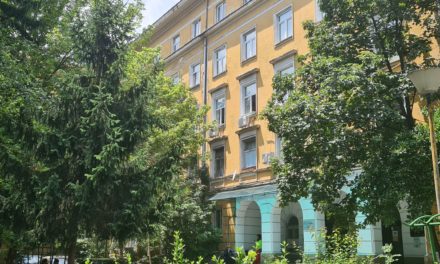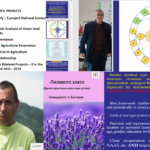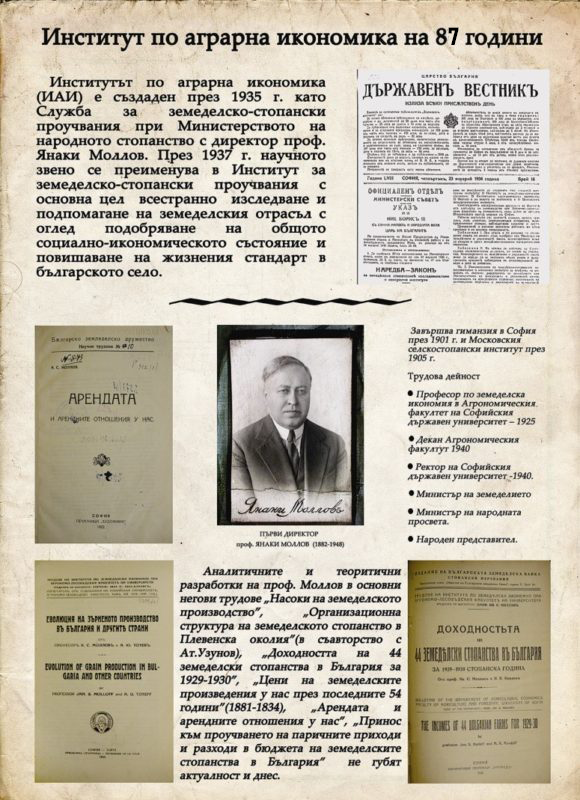Повече информация по регистрацията:
VII-и международeн научен форум “Аграрната политика в подкрепа на земеделието “-27 и 28.10.2020
Седмата международна научна конференция „Земеделие и снабдяване с храни: пазари и аграрна политика“, с организатор Институтът по аграрна икономика към ССА, ще се състои на 27 и 28 октомври 2020 г. в Бест Уестърн Плюс Хотел Експо, София, бул. Цариградско шосе, № 149.
Тази година акцентите са поставени върху следните теми:
- Хранително осигуряване и хранителни вериги;
- Земеделски и стокови пазари;
- Земеделски политики в здравната криза;
- Баланс в земеделието и околната среда;
- Кръгова икономика и устойчивост.
Във връзка с епидемиологичната обстановка (COVID-19) част от докладите ще бъдат представени виртуално (с видео запис). При необходими предпазни мерки, ще се състоят и присъствените дискусии.
ПРОГРАМА НА СЕДМАТА МЕЖДУНАРОДНАТА КОНФЕРЕНЦИЯ, 27-28 октомври, 2020:„Земеделие и снабдяване с храни: пазари и аграрна политика“, с организатор Институтът по аграрна икономика към ССА:
Programs – Conference 10.2020-BG
Programs – Conference 10.2020-EN
Предишни публикации в хода на подготовката на Конференцията:
REGISTRATION ON EMAIL: iae_conference2020@iae-bg.com
Contact person, PhD Anton Mitov tel: +359886070573
Deadline abstract – 15.07.2020
Approve response – 30.07.2020
Deadline for papers – 30.09.2020
Всичко за конференцията. Кликни върху картинката долу:
Conference 2020 “Agriculture and Food Supply: Markets and Policy Reflections”
Акцентите тази година чертаят приемственост с обсъдените на последните форуми теми и са насочени към повече екология и прилагане на научните изследвания и иновации в земеделието, от развитие на кръгова икономика и устойчивост, от отчитане на социално-икономическите фактори и динамиката на пазарите на земя в регионите. Фокус е и постигането на повече специализация и ефективност на селското стопанство в тях.
Изисквания за формата на публикациите:
SUBMISSION OF ARTICLES
The journal publishes original articles, reviews and short communications that contain original experimental data or new interpretations of existing results. They must comply with the themes of the journal and have not been published elsewhere. Plagiarism is unacceptable for the journal. Use of foreign ideas and images in their original form is allowed only in their exact citation. All submitted articles are checked for plagiarism and when there are large parts already published texts or data, the articles are rejected. We do not accept manuscripts that are fully or partially published in other publications. The manuscript, written in Bulgarian or English, should be submitted online.
Structuring of publication
Original articles should contain title, authors, abstract, key words, introduction, materials and methods, results and discussion, conclusions, references.
Text should be in Times New Roman font, in MS Office Word format. The measuring units (cm, m, km, t, l, g, kg, s, h, etc.) should be denoted according to the SI system. Latin names of plant and animal species should be given according to the International Classification, in Italic.
The text should be organized as follows:
TITLE: Title of the paper should be brief, accurately identifying the manuscript content, being written in bold capital letters, without any abbreviations. The forename and surname of each author are to be stated below, written in light (not bold) small letters. Institutions for which he/she works are to be written below, numbers in suffix should be used to refer the addresses of authors (1, 2…). E-mail of corresponding author should be mentioned, indicated with asterisk (*).
ABSTRACT AND KEY WORDS: Abstract reflects shortly and clearly the basic information and scientific impact of the article, with cited the main results obtained. Key words must be properly selected, giving the essence of the study. Bulgarian contributors must send abstract and key words in Bulgarian and English.
INRODUCTION: Introduction must answer the following questions: What is known and what is new on the studied issue? What necessitated the research problem, described in the manuscript? What is your hypothesis and aim?
MATERIAL AND METHODS: The objects of research, organization of experiments, chemical analyses, statistical and other methods and conditions applied for the experiments should be described in detail.
RESULTS AND DISCUSSION: Results of research can be presented separately from discussion or together in one paragraph. Presentation of results should be precise and without repetitions, and include the evaluation of significant differences and other parameters.
CONCLUSIONS: Present the most important consequences for the science and practice resulting from the conducted research. They should be summarized in few sentences.
ACKNOWLEDGEMENTS (if there are any)
TABLES AND FIGURES
Tables should be submitted on a separate sheet at the end of the text and must be cited in the text. They should be prepared in MS Word format – doc and docx files (only when there is special need – in xls files). Tables are numbered in Arabic numerals according to their sequence in the text. Each column in the table must have heading and, when necessary, abbreviations should be explained in the legend.
Illustrations (maps, charts, graphs, drawings, photos, etc.) are to be referred to as ‘Figures’ and numbered in sequence. They should be as clear and free from text, presented as in format tif, png, xls, eps. Numeration and title of the figures are placed below the figure, with all necessary indications presented. It is recommended the figures to be in black and white. Provide figures and photographs with good dark and light contrast. Prepare drawings with dark, heavy lines as to be appropriate for printing.
All tables and illustrations must be cited in the text. Bulgarian contributors must send texts and titles of tables, figures, graphs and photos in Bulgarian and English.
ABBREVIATIONS
Abbreviations may be used for other expressions provided that, when first mentioned, they are defined in full, followed by the abbreviation in parenthesis and used consistently thereafter.
REFERENCES
In the text, references should be cited as follows: single author (Morris, 1991); two authors (Barton and Moore, 1994); more than two authors (Levi et al., 1994). When several references are cited simultaneously, they should be ranked by chronological order e.g.: (Petrovic et al., 2011; 2015) and when their publications are in the same year – alphabetically. All published works referred to in the text must be listed in the reference list and vice versa.
Reference list is arranged alphabetically (by the surname of the first author) and chronologically. When citing several publications by the same author, his individual publications are given first, followed by publications in co-authorship (with one co-author, two co-authors, etc.). It is desirable to list the names of all authors.
Names of authors and journal titles in Cyrillic or alphabet different from Latin should be transliterated into Latin and article titles should be translated into English. The original language of articles and books translated into English is indicated in brackets after the bibliographic reference (in Bulgarian = Bg, in Russian = Ru, in Serbian = Sr, in Chinese – Ch, etc.).
Example: Bachev, H. (2015). Framework for assessing sustainability of agricultural farms. Ikonomika i upravlenie na selskoto stopanstvo, 60(3), 12-36 (Bg).
In transliteration, letters are replaced as follow: А=A, Б=В, В=V, Г=G, Д=D, Е=Е, Ж=Zh, 3=Z, И=I, Й=Y, K=К, Л=L, М=М, Н=N, О=О, П=Р, Р=R, С=S, Т=Т, У=U, Ф=F, X=H, Ц=Тs, Ч=Сh, Ш=Sh, Щ=Sht, Ъ=А, Ь=Y, Ю=Yu, Я=Ya.
The journal follows APA citation style. Data in the reference list should be cited as follows:
- Journal articles
Author(s) surname and initials, given bold, year, title, journal title (in italic), volume, number, pages. Examples:
Yau, S. K. & Hamblin, J. (1994). Relative yield as a measure of entry performance in variable environments. Crop Science, 34(3), 813-817.
Rigby, D., Woodhouse, P., Young, T. & Burton, M. (2001). Constructing a farm level indicator of sustainable agricultural practice. Ecological Economics, 39(3), 463-478.
- Books
Author(s) surname and initials given bold, year, title, edition, name of publisher, place of publishing. Example:
Lidanski, T. (1998). Statistical methods in biology and agriculture. Zemizdat, Sofia (Bg).
VanLoon, G., Patil, S. & Hugar, L. (2005). Agricultural Sustainability: Strategies for Assessment. SAGE Publications, London.
- Book chapters or conference proceedings
Author(s) surname and initials, given bold, year, title. In: Title of the book or of the proceedings followed by the editor(s), name of publisher, place of publishing, volume, pages. Example:
McGrath, S. P. (1998). Phytoextraction for soil remediation. In: Plants that hyperaccumulate heavy metals (ed. Brooks R. R.). CAB Int., Wallingford, UK, 261-287.
Dirimanova, V. (2015). Good practices for the environment in the crop production. In: Changes and perspectives in the rural areas and in the agriculture of Bulgaria, Poland and other EU member states. Sofia: Avangard Prima, 145-151.
- Abstracts of reports on scientific forums
Cerdà, A., Burguet, M. & Keesstra, S. (2016). The impact of agriculture terraces on soil organic matter, aggregate stability, water repellency and bulk density. In: EGU General Assembly Conference (Abstracts), Vol. 18, p. 18104.
- Dissertations and Phylosophy Doctor Theses
Petrova, V. (2015). Economically important pests of apple and fight with them at various technologies of cultivation. Dissertation, Kyustendil, Bulgaria.
Kenyon, L. (1990). Pathogenicity mutants of Fulvia fulva (Cooke). Ph.D. thesis, University of East Anglia, UK.
- Online publications
Jarchow, M. E. (2012). Tradeoffs in ecosystem services of prairies managed for bioenergy production. Graduate Theses and Dissertations. Paper 12619. http://lib.dr.iastate.edu/etd/12619/
Bachev, H. (2014). Forms, factors and efficiency of eco-management in Bulgarian farms with high eco-activity. MPRA paper 58664. https://mpra.ub.uni-muenchen.de/58664/
PUBLISHING OF ARTICLES
After the reception of the article, the manuscript is given to referees for anonymous peer review. Authors will be notified about the acceptance or rejection of the manuscripts. The corrected manuscript should be submitted to the website of the journal.
ВСИЧКИ ЗАГЛАВИЯ И УЧАСТИЯ /англ./
- EFFECTS OF FARM SPECIALIZATION, ENVIRONMENTAL SUBSIDIES AND AGRO-DISTRICTS ON TECHNICAL EFFICIENCY IN ITALIAN FARMS – Nicola Galluzzo (Association of Geographical and Economic Studies of Rural Areas (ASGEAR)
- System Failures in the Implementation of the EIP-AGRI Interactive Innovation Approach in Bulgarian Agricultural Policy – Svetla Stoeva and Dona Pickard (Institute for the Study of Societies and Knowledge at the Bulgarian Academy of Sciences (ISSK-BAS)
- Market integration in the EU pork market – evidence from nonlinear panel models – Mariusz Hamulczuk (Warsaw University of Life Sciences (WULS-SGGW)
- OVERVIEW ON THE BIOECONOMY STRATEGIES AND THE MAIN CHALLENGES FOR CENTRAL AND EASTERN EUROPEAN COUNTRIES – Dan-Marius Voicilas (Romanian Academy, Institute of Agricultural Economics, Bucharest)
- Agriculture in rural areas – regional differences and models – Julia Doitchinova and Zornitsa Stoyanova (University of National and World Economy)
- Approach for Risk Assessment in Agriculture. Example from African Swine Fever in Bulgaria – Bozhidar Ivanov (Institute of Agricultural Economics, Sofia)
- MODELING MEAT CONSUMPTION AND MEDIUM-TERM PROSPECTS – Bozhidar Ivanov, Daniela Dimitrova (Institute of Agricultural Economics, Sofia Center for Agricultural Policy Analysis (CAPA)
- Bioeconomic evaluation of Bulgarian regions – Vassil STOYCHEV*, Bozhidar IVANOV
(Institute of Agricultural Economics (IAE), Sofia)
- COMPETITIVENESS OF BULGARIAN DAIRY AND MEAT SECTORS – Vassil Stoychev (Institute of Agricultural Economics, Sofia)
- Direct payments in Serbia and the transition to EU compatible direct support –
- Snezhana Blagoeva, (Ministry of Agriculture, Food and Forestry, Bulgaria)
The Romanian Grain Market : A complete analysis of the evolution and current state – Lacramioara Dracea (Drăcea (Vasile) Lăcrămioara Alina Academia de Studii Economice Bucuresti)
- Significance of Socio-Economic Distinctions at Regional Types in Bulgaria – Ivaylo Todorov – PhD Candidate (Economic University, Varna)
- THE IMPACT OF THE ADAPTATION OF THE MACEDONIAN AGRICULTURAL POLICY ON THE PRODUCTION STRUCTURE – CONSIDERATION FOR THE EU NEGOTIATION PERIOD – Dragi Dimitrievski, Ana Kotevska, Aleksandra Martinovska Stojcevska, Ivana Janeska Stamenkovska, Risto Elenov (INSTITUTE OF AGRICULTURAL ECONOMICS – Skopje)
- THE LEVEL OF INTERNET ACCESS FOR RURAL ROMANIAN – Izvoranu Anca-Marina (Institute of Agricultural Economics, Romanian Academy)
- WINE AND SPA-TOURISM IN RURAL AREAS OF BULGARIA: CHALLENGES AND SUSTAINABILITY – Vladimir Dimitrov (Institute of Viticulture and Enolgy, Pleven, Bulgaria)
- COVID-19 impact on wheat market in Bulgaria, Europe and Black Sea
Region – Doriana Milenkova, PhD candidate at (Institute of Agrarian Economics, Sofia,Bulgaria)
- CEREAL PRODUCTION STABILITY IN ROMANIA IN THE CONTEXT OF THE COVID-19 PANDEMIC – Mihaela KRUZSLICIKA (PhD Scientific Researcher, Institute of Agrarian Economics, Romanian Academy, Bucharest, Romania)
- Management accounting in the theory and practice of Bulgarian agricultural farms – Anelia Lyubenova, PhD, mag. Georgi Stoilov
- Marketing Beekeeping Strategies in the circular economy of Ruse region – Lyubomir Lyubenov (Department of Economics, Angel Kanchev University of Ruse)
- Natural resource potential – a basis for the development of bio economics in Bulgaria – Chief Assistant Desislava Toteva, PhD, Chief Assistant Petar Marinov, PhD (Institute of Agricultural Economics – Sofia, Bulgaria)
- Factor for regional differences in yields in northern and southern Bulgaria – Bozhidar Ivanov, Petko Smieonof, Mihaela Mihailova (Institute of Agricultural Economics – Sofia, Bulgaria)
- Dynamics of the agricultural land market in Bulgaria until the accession to the EU – Mihaela Mihailova (Institute of Agricultural Economics – Sofia, Bulgaria)
- SUPLY AND DEMAND OF DIGITAL SERVICES IN AGRICULTURE. Authors: Bozhura Fidanksa PhD Student*Associate Professor Peter Borisov PhD**Prof. Dimitre Nikolov PhD
- AGRO-ECOLOGICAL CONDITIONS AND REGIONAL FEATURES IN THE PRODUCTION OF WHEAT AND SUNFLOWER-assist.prof. PhD Rositza Mikova,Institute of agricultural economics – Sofia, Agricultural academia
УЧАСТИЯ /на български език/
- ЕФЕКТИ ОТ СПЕЦИАЛИЗАЦИЯТА НА ФЕРМИТЕ, СУБСИДИИТЕ ЗА ЕКОЛОГИЯ И АГРАРНИ РАЙОНИ ВЪРХУ ТЕХНИЧЕСКАТА ЕФЕКТИВНОСТ НА ИТАЛИАНСКИТЕ ФЕРМИ – Nicola Galluzzo (Association of Geographical and Economic Studies of Rural Areas (ASGEAR)
- СИСТЕМНИ НЕУСПЕХИ ПРИ ИЗПЪЛНЕНИЕТО НА ИНТЕРАКТИВНИЯ ИНОВАЦИОНЕН ПОДХОД EIP-AGRI В БЪЛГАРСКАТА СЕЛСКОСТОПАНСКА ПОЛИТИКА – Svetla Stoeva and Dona Pickard (Institute for the Study of Societies and Knowledge at the Bulgarian Academy of Sciences (ISSK-BAS)
- ПАЗАРНА ИНТЕГРАЦИЯ НА ПАЗАРА ЗА СВИНСКО МЕСО В ЕС – MARKET INTEGRATION IN THE EU PORK MARKET – ДОКАЗАТЕЛСТВА ОТ НЕЛИНЕЙНИ ПАНЕЛНИ МОДЕЛИ – Mariusz Hamulczuk (Warsaw University of Life Sciences (WULS-SGGW)
- ПРЕГЛЕД НА БИОИКОНОМИЧЕСКИТЕ СТРАТЕГИИ И ОСНОВНИТЕ ПРЕДИЗВИКАТЕЛСТВА ЗА СТРАНИТЕ ОТ ЦЕНТРАЛНА И ИЗТОЧНА ЕВРОПА – Dan-Marius Voicilas (Romanian Academy, Institute of Agricultural Economics, Bucharest)
- ЗЕМЕДЕЛИЕТО В СЕЛСКИТЕ РАЙОНИ – РЕГИОНАЛНИ РАЗЛИКИ И МОДЕЛИ – Julia Doitchinova and Zornitsa Stoyanova (University of National and World Economy)
- ПОДХОД ЗА ОЦЕНКА НА РИСКА В ЗЕМЕДЕЛИЕТО: ПРИМЕР ОТ АФРИКАНСКАТА ЧУМА ПО СВИНЕТЕ В БЪЛГАРИЯ – Bozhidar Ivanov (Institute of Agricultural Economics, Sofia)
- МОДЕЛИРАНЕ НА ПОТРЕБЛЕНИЕ НА МЕСО И СРЕДНОСРОЧНИ ПЕРСПЕКТИВИ – Bozhidar Ivanov, Daniela Dimitrova (Institute of Agricultural Economics, Sofia Center for Agricultural Policy Analysis (CAPA)
- БИОИКОНОМИЧНА ОЦЕНКА НА БЪЛГАРСКИТЕ РЕГИОНИ – Vassil Stoychev, Bozhidar Ivanov (Institute of Agricultural Economics (IAE), Sofia)
- КОНКУРЕНТОСПОСОБНОСТ НА БЪЛГАРСКИТЕ МЛЕЧНИ И МЕСНИ СЕКТОРИ – Vassil Stoychev (Institute of Agricultural Economics, Sofia)
- ДИРЕКТНИ ПЛАЩАНИЯ В СЪРБИЯ И ПРЕХОДЪТ КЪМ СЪВМЕСТИМА ДИРЕКТНА ПОДКРЕПА НА ЕС – Snezhana Blagoeva, (Ministry of Agriculture, Food and Forestry, Bulgaria)
- РУМЪНСКИЯТ ПАЗАР НА ЗЪРНО: ПЪЛЕН АНАЛИЗ НА ЕВОЛЮЦИЯТА И ТЕКУЩОТО СЪСТОЯНИЕ – Lacramioara Dracea (Drăcea (Vasile) Lăcrămioara Alina (Academia de Studii Economice Bucuresti)
- ЗНАЧЕНИЕ НА СОЦИАЛНО-ИКОНОМИЧЕСКИТЕ РАЗГРАНИЧЕНИЯ НА РЕГИОНАЛНИТЕ ТИПОВЕ В БЪЛГАРИЯ – Ivaylo Todorov (Economic University, Varna)
- ВЪЗДЕЙСТВИЕТО НА АДАПТАЦИЯТА НА МАКЕДОНСКАТА ЗЕМЕДЕЛСКА ПОЛИТИКА ВЪРХУ ПРОИЗВОДСТВЕНАТА СТРУКТУРА – РАЗГЛЕЖДАНЕ НА ПЕРИОДА НА ПРЕГОВОРИ С ЕС – Dragi Dimitrievski, Ana Kotevska, Aleksandra Martinovska Stojcevska, Ivana Janeska Stamenkovska, Risto Elenov (Institute Of Agricultural Economics – Skopje)
- СТЕПЕН НА ДОСТЪП ДО ИНТЕРНЕТ ЗА СЕЛСКИТЕ РАЙОНИ В РУМЪНИЯ – Izvoranu Anca-Marina (Institute of Agricultural Economics, Romanian Academy)
- ВИНЕН И СПА-ТУРИЗЪМ В БЪЛГАРИЯ: ПРЕДИЗВИКАТЕЛСТВА И УСТОЙЧИВОСТ – Vladimir Dimitrov (Institute of Viticulture and Enolgy, Pleven, Bulgaria)
- ВЪЗДЕЙСТВИЕТО НА COVID-19 ВЪРХУ ПАЗАРА НА ПШЕНИЦА В БЪЛГАРИЯР ЕВРОПА И ЧЕРНОМОРСКИЯ РЕГИОН – Doriana Milenkova (Institute of Agrarian Economics, Sofia, Bulgaria)
- СТАБИЛНОСТ НА РУМЪНСКОТО ЗЪРНОПРОИЗОВДСТВО В КОНТЕКСТА НА ПАНДЕМИЯТА ОТ COVID-19 – Mihaela KRUZSLICIKA (Institute of Agricultural Economics, Romanian Academy, Bucharest, Romania)
- УПРАВЛЕНСКО СЧЕТОВОДСТВО В ТЕОРИЯТА И ПРАКТИКАТА НА БЪЛГАРСКИТЕ ФЕРМИ – Anelia Lyubenova, Georgi Stoilov
- МАРКЕТИНГОВИ СТРАТЕГИИ В ПЧЕЛАРСТВОТО В КРЪГОВАТА ИКОНОМИКА НА РУСЕНСКИ РЕГИОН – Lyubomir Lyubenov, Angel Kanchev (Department of Economics, University of Ruse)
- ПОТЕНЦИАЛЪТ НА ПРИРОДНИТЕ РЕСУРСИ – БАЗА ЗА РАЗВИТИЕ НА БИО-ИКОНОМИКАТА В БЪЛГАРИЯ – Dessislava Toteva, Petar Marinov, (Institute of Agricultural Economics – Sofia, Bulgaria)
- ФАКТОР ЗА РЕГИОНАЛНИТЕ РАЗЛИЧИЯ В ДОБИВИТЕ В СЕВЕРНА И ЮЖНА БЪЛГАРИЯ – Bozhidar Ivanov, Petko Simeonov, Mihaela Mihailova (Institute of Agricultural Economics – Sofia, Bulgaria)
- ДИНАМИКА НА СЕЛСКОСТОПАНСКИЯ ПОЗЕМЛЕН ПАЗАР В БЪЛГАРИЯ ДО ПРИСЪЕДИНЯВАНЕТО КЪМ ЕС – Mihaela Mihailova (Institute of Agricultural Economics – Sofia, Bulgaria)
- ПРЕДЛАГАНЕ И ТЪРСЕНЕ НА ДИГИТАЛНИТЕ УСЛУГИ В ЗЕМЕДЕЛИЕТО – Bozhura Fidanksa PhD Student** Associate Professor Peter Borisov PhD**Prof. Dimitre Nikolov PhD*
24. АГРОЕКОЛОГИЧНИ УСЛОВИЯ И РЕГИОНАЛНИ ОСОБЕНОСТИ ПРИ ПРОИЗВОДСТВОТО НА ПШЕНИЦА И СЛЪНЧОГЛЕД -assist.prof. PhD Rositza Mikova,Institute of agricultural economics – Sofia, Agricultural academia










